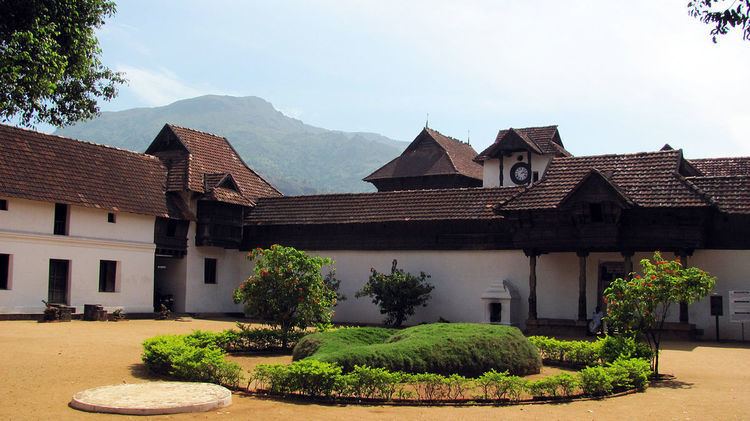Opened 1601 Function Palace | Phone 04651 250 255 | |
 | ||
Hours Closed today MondayClosedTuesday9AM–4:30PMWednesday9AM–4:30PMThursday9AM–4:30PMFriday9AM–4:30PMSaturday9AM–4:30PMSunday9AM–4:30PM Similar Napier Museum, Padmanabhaswamy Temple, Vattakottai Fort, Thanumalayan Temple, Vivekananda Rock Memorial | ||
Padmanabhapuram Palace (Malayalam: പത്മനാഭപുരം കൊട്ടാരം)is a Travancore -era palace located in Padmanabhapuram, Kanyakumari District, Tamil Nadu. It is owned and maintained by the Government Of Kerala.
Contents
- Construction
- Unique Rooms
- Council Chamber
- Queen Mothers Palace
- Performance Hall
- Central mansion
- Southern Palace
- Other features
- References
Padmanabhapuram is the former capital city of the erstwhile Hindu Kingdom of Travancore. It is around 20km from Nagercoil, and 50km from Thiruvananthapuram city. The palace is complex inside with an old granite fortress around four kilometers long. The palace is located at the foot of the Veli Hills, which forms a part of the Western Ghats. The river Valli flows nearby.
Construction
The palace was constructed around 1601 AD by Iravi Varma Kulasekhara Perumal who ruled Venad between 1592 and 1609. It is believed that the Thai Kottaram was built in 1550. The founder of modern Travancore, King Anizham Thirunal Marthanda Varma (1706–1758) who ruled Travancore from 1729 to 1758, rebuilt the palace in around 1750. King Marthaanda Varma dedicated the kingdom to his family deity Sree Padmanabha, a form of Lord Vishnu and ruled the kingdom as Padmanabha dasa or servant of Lord Padmanabha. Hence the name Padmanabhapuram or City of Lord Padmanabha. In the late 18th century, precisely in 1795 the capital of Travancore was shifted from here to Thiruvananthapuram, and the place lost its former glory. However, the palace complex continues to be one of the best examples of traditional Kerala architecture, and some portions of the sprawling complex are also the hallmark of traditional Kerala style architecture. The Palace though surrounded entirely by the State of Tamil Nadu is still part of Kerala and the land and Palace belongs to the Government of Kerala. This Palace is maintained by the Govt.of Kerala Archaeology Department.
Unique Rooms
The Padmanabhapuram Palace complex consists of several structures:
Council Chamber
King’s Council chamber is the most beautiful part of the entire palace complex. It has windows, with coloured mica, which keep the heat and the dust away, and the interior of the council chamber remains cool and dark. Delicate and beautiful lattice work can be seen all over the council chamber.
The floor is also beautifully done, with a fine and perfect finish. The floor is dark and is made of a mixture of varied substances, including burnt coconut shells, egg white and so on. The remarkable aspect is that this particular floor finish and texture could not be duplicated in any other construction.
Queen Mother's Palace
Mother’s palace, designed in traditional Kerala style, is the oldest construction in the entire palace complex and is believed to be constructed around mid-16th century. True to the traditional Kerala style, there is an inner courtyard, called 'nalukettu'. In the inner courtyard, sloping roofs from all four sided taper down. Four pillars on four corners support the roof.
On the south-west corner of the mother’s palace, there is a relatively small room, called the chamber of solitude or 'ekantha mandapam'. The chamber of solitude has very beautiful and intricate wood carvings of every description all around. Of particular interest is a pillar of single jackfruit wood, with very detailed and beautiful floral designs.
Performance Hall
This is a relatively new building, constructed at the behest of Maharaja Swathi Thirunal, who reigned in Travancore from 1829 to 1846. He was a great connoisseur of arts, especially music and dance. He himself composed music and has left a rich legacy to classical carnatic music.
The Nataksala or the hall of performance has solid granite pillars and gleaming black floor. There is a wooden enclosure, with peepholes, where the women of the royal household used to sit and watch the performance.
Central mansion
The four-storeyed building is located at the centre of the palace complex. The ground floor houses the royal treasury. The first floor houses the King's bedrooms. The ornamental bedstead is made of 64 types of herbal and medicinal woods, and was a gift from the Dutch merchants. Most of the rooms here and in other parts of the palace complex have built-in recesses in walls for storing weapons like swords and daggers. The second floor houses the King's resting and study rooms. Here the King used to spend time during fasting days. The top floor (called upparikka malika) served as the worship chamber of the royal household. Its walls are covered with exquisite 18th century murals, depicting scenes from the puranas, and also few scenes from the social life of the Travancore of that time. The top floor was supposed to be Sree Padmanabha Swamy's room. This building was constructed during the reign of King Marthandavarma. He was also designated as Padmanabha Dasa and used to rule the Travancore kingdom as a servant of Sree Padmanabha Swamy.
Southern Palace
The southern palace is as old as the ‘Thai kottaram’ (Mother's palace), which would make it about 400 years old. Now, it serves as a heritage museum, exhibiting antique household articles and curios. Collections of items give an insight into the social and cultural ethos of that period.
Other features
The Padamnabhapuram Palace complex has several other interesting features:
